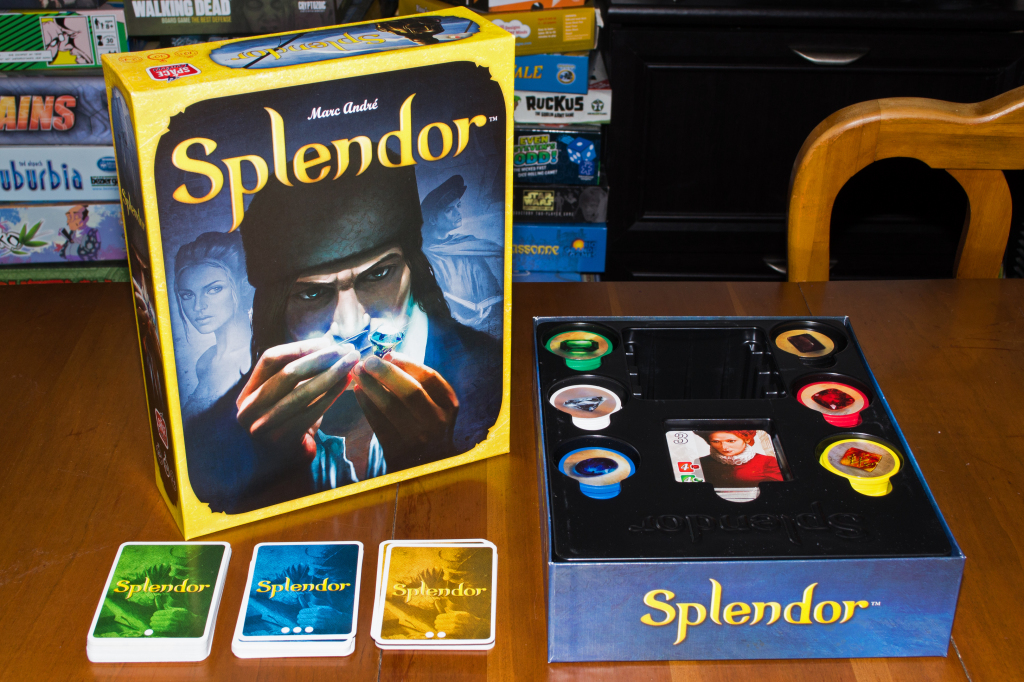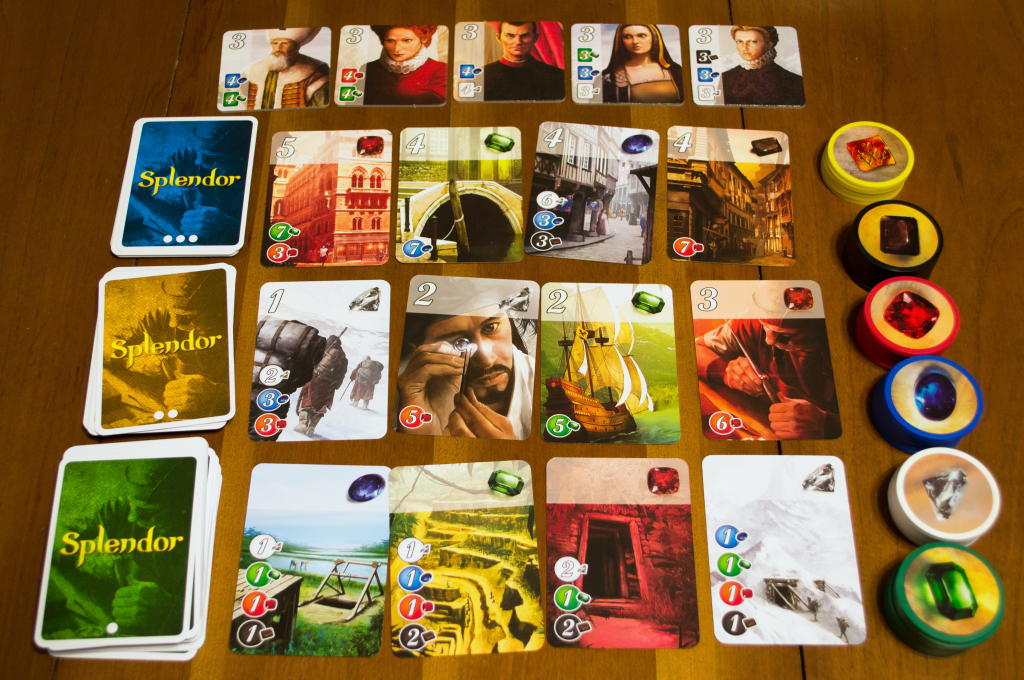“Splendor” puts you in the role of a merchant during the Renaissance period. Your goal will be to increase your prestige by purchasing cards (mines, shops, etc.) with differently colored chips (gems) that you can collect on a regular basis. Since all cards have varying costs and require different gem colors, it’ll be a race to see who can best manage their resources and make the most logical purchases based on the situation as it presents itself. In other words, there’s a heavy focus on chip collecting and card development. This might sound a bit complicated to some but it has a play time of only thirty minutes…meaning you won’t spend hours scratching your head and yearning for the game to “just be over already”. Quite the contrary, in fact.
Components
Cards – The game includes three decks of cards that will populate the available pool. The cards with the green backs are the cheapest cards to buy while the cards with the blue backs are usually the most expensive to buy. Of course, the rewards on the latter cards are a bit higher. Rewards are two-fold: the number on the upper left will tell you how many prestige points you’ve earned (if any) while the gem in the upper right can be used as a resource when buying other cards. The idea here is that in the beginning, you’ll be buying cheaper cards utilizing only your chips. As you acquire more cards, you can use your cards’ passive resources (in addition to your chips) to help you afford the more expensive cards.
Chips (Gems) – There are six different colored chips in the game, five of which correspond to the card colors: green, blue, yellow, white, and black. The gold chips are wild.
Tiles (Nobles) – These square cards/tiles are awarded to players that have enough wealth of a particular gem combination via the cards they have purchased. They grant a bonus to prestige, which in turn helps players win the game.
Setup & Gameplay
Game setup will vary depending on how many people are playing the game (you’ll use less nobles & chips with two/three players). In short, you’ll shuffle the three decks separately and deal so many cards (face up) from each, forming a grid. The green cards will be dealt horizontally along the bottom of the grid, the yellow cards will be dealt horizontally along the middle of the grid, and the blue cards will be dealt horizontally along the top of the grid. So many nobles are dealt (face up) above the grid while the chips are placed into stacks nearby.
On a player’s turn, they can perform ONE of the following actions:
1. Take up to three differently colored chips OR if there are at least four chips available in a stack, you can take two of that color. You many only have ten chips in your possession at a time, so you’ll need to discard chips (give them back to the bank) if you go over the limit.
2. Reserve a card by placing it into your hand (hidden from other players) AND take a gold chip. A player can only have three reserved cards at a time. Immediately draw a new card from the appropriate deck to refill the pool.
3. Purchase a card from either your reserve or the available pool. This card is placed face up in you. Immediately draw a new card from the appropriate deck to refill the pool.
Nobles are automatically granted to a player at the end of a turn IF they meet the requirement listed on the tile. Limit one noble per turn AND no new tiles are drawn to replace them.
The first player to reach 15 prestige points signals the game ending condition. Each player finishes off the round in a way so that each player gets an equal number of turns. The person with the most prestige points after that, wins the game!
Note: The above doesn’t cover all of the rules found in the manual, but should give you an idea as to how the game is played.
The Review
In a lot of the games I play, accumulating wealth is often an uphill battle. Whether I am playing “Suburbia”, “Power Grid”, “Monopoly”, or almost any digital simulator like “SimCity”, I find myself needing more money and I often have to scheme and strategize in order to obtain it. Not the case with “Splendor”, surprisingly. While there isn’t money in this game per se’, you will need to obtain certain colored gems in order to buy various cards. The difference here is that earning gems is as simple as choosing to do so on your turn, but which gems you decide to take based on the cards currently available is where the real strategy comes into play. After all, the pool is constantly changing as players buy and reserve cards.
Therein lies the appeal to this game, at least to me. It’s not only a question of whether or not I can obtain the chips I’ll need to purchase the cards, but will the cards be available by the time I have enough to buy them? The available pool of cards is constantly in flux and if you’re playing against an observant opponent, they can pull the rug right out from under you and reserve cards they see you going after. There’s also the fact that there are five different colors one can save for…if there’s a shortage on one color in the bank, it’s easy enough to switch tactics temporarily and go after another color or two. Of course, it’s tempting to keep after a particular color when the noble tiles require it in order to be won.
I suppose what I’m getting at here is that “Splendor” is a game about making decisions. You’ll often spend your turn thinking about what you want to go after based on the available cards and the noble tiles available. For this reason I don’t consider “Splendor” to be “fast-paced” because the situation and card combinations are always changing. This can be good or bad, depending on what kind of games you prefer. I will come right out and say however that the game is easy to learn and teach to others. Moreover, you could technically blow through a game quickly IF you don’t mind not thinking through all of the possibilities on the table…hey, some people are fine with that (myself included, depending on my mood).
“Splendor” is indeed an excellent game worth picking up. Since no two games are ever the same, it has an incredibly high replayability value. The fact that I find the game to be addicting is just icing on the cake. The components themselves are colorful and fit the theme while the instructions were an easy read. The chips were nicely weighted, which is an added bonus. It didn’t take me long to grasp everything after about ten to twenty minutes. All in all, an easy recommend for kids and adults alike.
Final Verdict: 9/10
—


